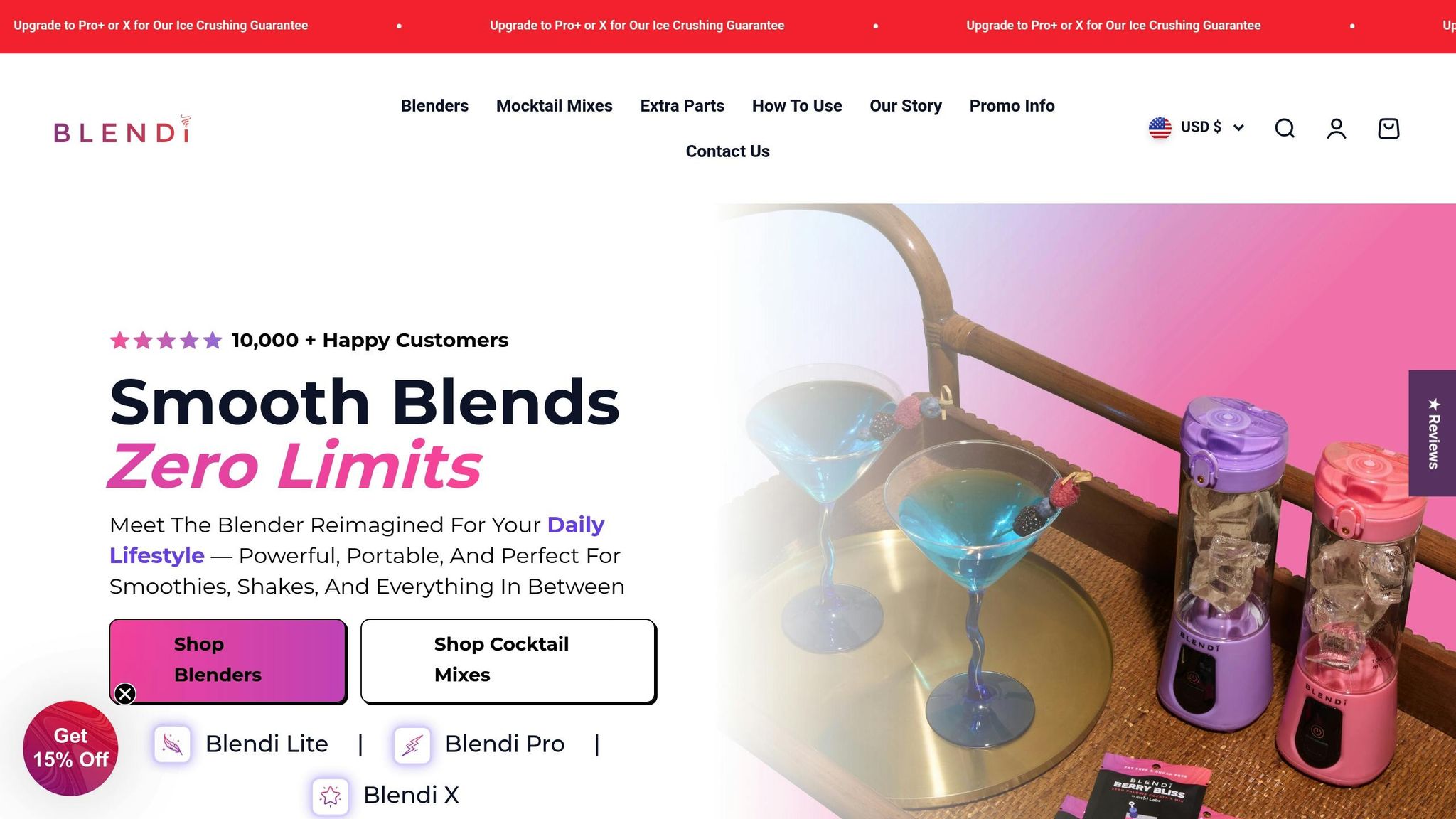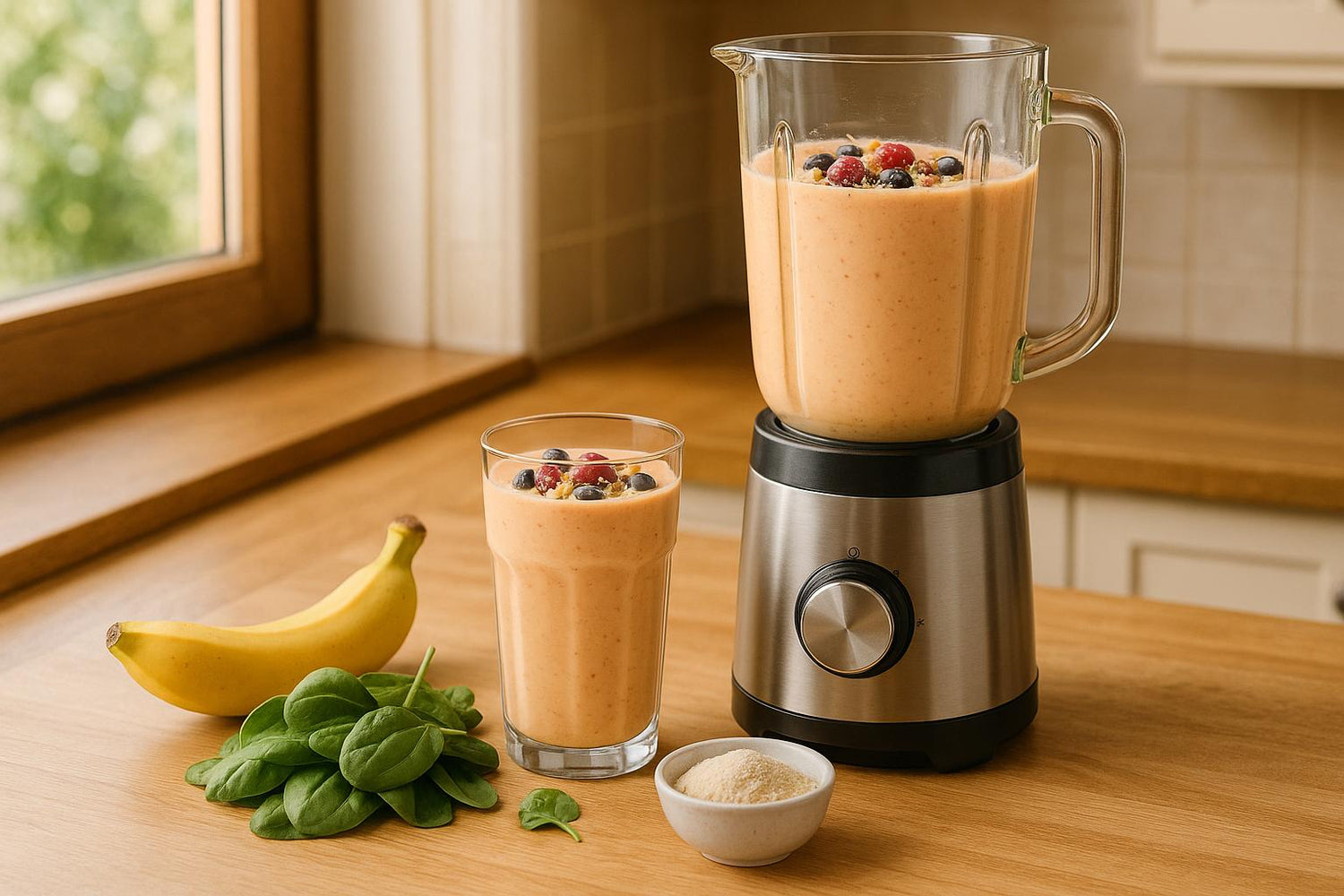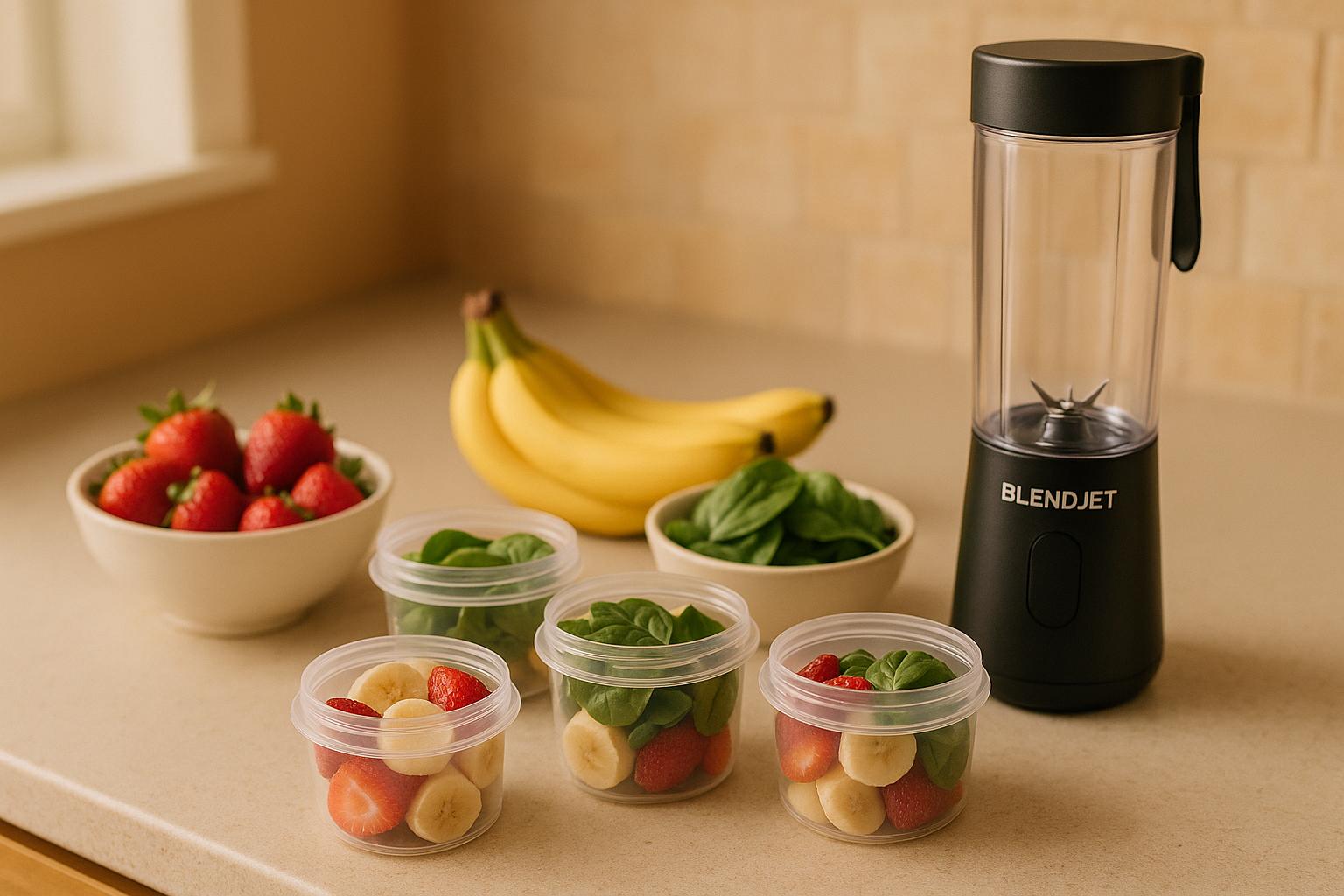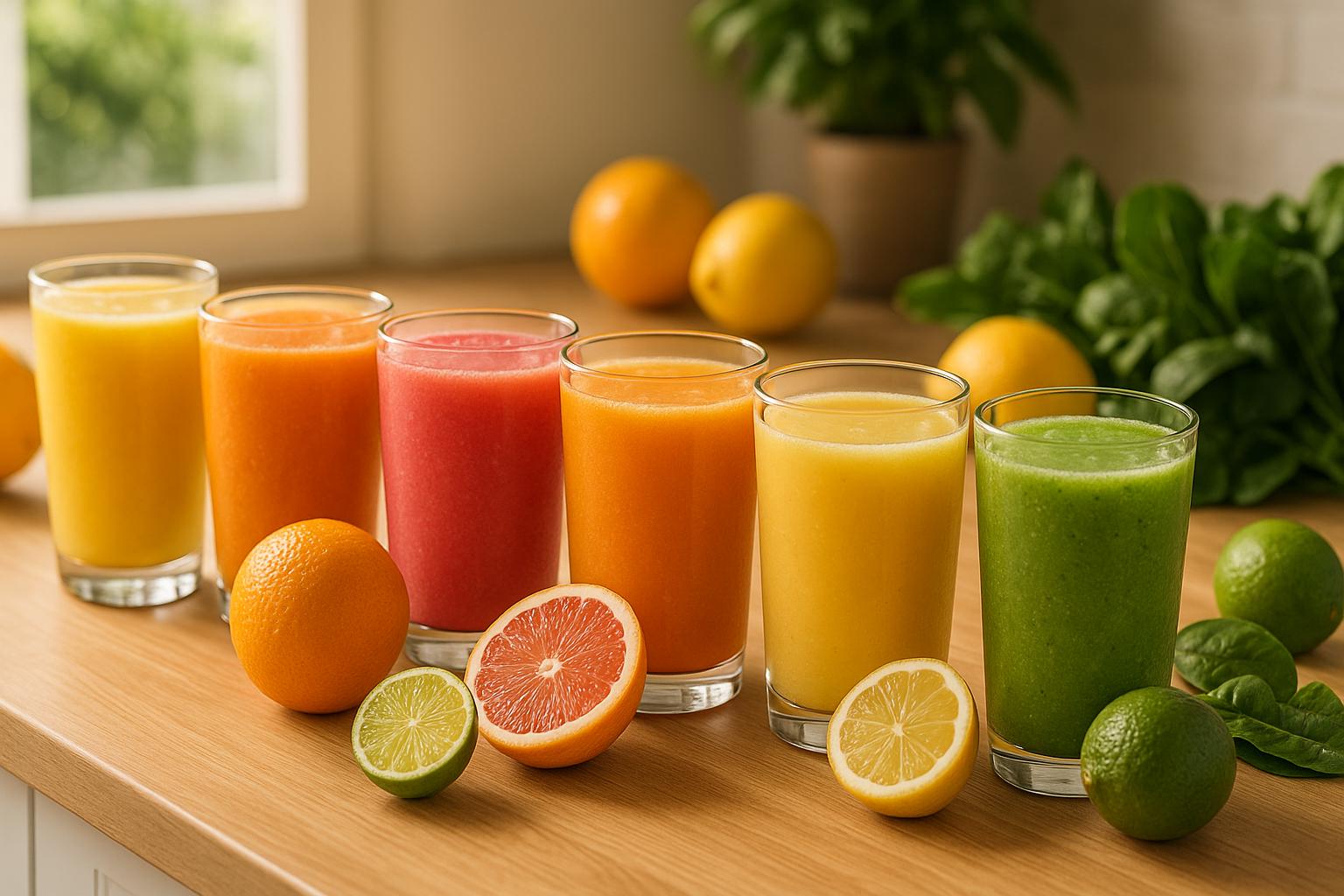High-protein smoothies are an easy way for seniors to meet their daily nutritional needs, especially when eating solid foods is challenging. Protein is key for maintaining muscle, reducing the risk of falls, and supporting overall health as you age. Here’s what you need to know:
- Why Protein Matters: After 30, muscle mass decreases by 3–8% per decade. Seniors need 1–1.2 grams of protein per kilogram of body weight daily. For a 165-pound person, that's 75–90 grams of protein.
- Smoothie Benefits: Smoothies are simple to digest, help with hydration, and can be customized for specific health needs like heart health, joint support, or cognitive function.
-
Key Ingredients:
- Protein Bases: Greek yogurt, cottage cheese, silken tofu, soy milk, or cow’s milk.
- Protein Boosters: Whey or pea protein powder, chia seeds, flaxseeds, nut butters, or oats.
- Fruits & Veggies: Bananas, berries, spinach, avocado, or frozen fruits for flavor and texture.
Quick Steps to Make a Smoothie:
- Start with a liquid base (milk, yogurt, or alternatives).
- Add protein powder or seeds.
- Blend with fruits and vegetables.
- Adjust consistency with water or ice.
For convenience, portable blenders like BLENDi make preparation and cleanup fast and simple. Try recipes like Strawberry Vanilla, Chocolate Peanut Butter, or Avocado-Spinach smoothies, each packing 20–26 grams of protein per serving.
Meal Replacements for Active Seniors - Fast and healthy smoothies for people 60 and plus!
Nutritional Needs of Seniors
As we age, our calorie needs decrease, but our bodies demand more protein, vitamins, and minerals. This shift makes it essential to focus on nutrient-packed foods, and high-protein smoothies stand out as a convenient and effective option for seniors.
Why Protein Matters for Seniors
Protein becomes increasingly crucial with age, but many seniors struggle to meet their daily needs. Here's a startling fact: after turning 30, adults lose 3–8% of their muscle mass every decade.
Not getting enough protein affects more than just muscles. It plays a key role in maintaining bone strength, aiding recovery from injuries, supporting the immune system, and managing weight. Protein also contributes to better cognitive health and sustained energy levels. Experts suggest seniors aim for 1.0–1.2 grams of protein per kilogram of body weight daily. For someone weighing 165 pounds, that's about 75–90 grams of protein a day. Yet nearly half of adults over 51 fall short of these recommendations.
"Seniors who consume enough protein can stay healthy as they age, facilitate recovery, and lead active and meaningful lives." – Senior Solutions Home Care
To maximize its benefits, protein should be spread across meals throughout the day. This approach helps the body use it more effectively for muscle repair and maintenance. Pairing a protein-rich diet with regular resistance exercises further boosts muscle preservation and strength. But protein isn't the only nutrient seniors need to prioritize.
Other Important Nutrients to Include
While protein is critical, aging bodies also require a variety of other nutrients. The body's ability to absorb essential vitamins and minerals declines with age, making nutrient-dense foods a priority.
Dr. Sarah Booth, director of the Jean Mayer USDA Human Nutrition Research Center on Aging at Tufts University, highlights this:
"For older adults, this means choosing foods that are high in protein, vitamins and/or minerals but do not contain a lot of calories because our energy needs decline with age."
Some key nutrients that deserve attention include potassium, calcium, vitamin D, dietary fiber, and vitamin B12. For instance, 30% of seniors over 70 are deficient in vitamin D. These nutrients are essential for bone strength, heart health, digestion, and even cognitive performance.
| Nutrient | Men ≥ 71 Years | Women ≥ 71 Years | Key Benefits |
|---|---|---|---|
| Calcium | 1,000 mg | 1,000 mg | Bone health, muscle function |
| Vitamin D | 10 mcg | 10 mcg | Bone health, immune function |
| Vitamin B12 | 2.0 mcg | 2.0 mcg | Nerve function, energy production |
| Potassium | 4,700 mg | 4,700 mg | Heart health, blood pressure |
| Vitamin C | 75 mg | 60 mg | Immune support, wound healing |
The numbers paint a clear picture: fewer than half of U.S. adults aged 71 and older meet federal dietary guidelines. High-protein smoothies offer a practical way to address these gaps. When thoughtfully prepared, they combine protein, vitamins, minerals, fiber, and hydration into a single, easy-to-enjoy drink - perfect for seniors aiming to meet their nutritional needs.
Selecting High-Protein Ingredients for Smoothies
Creating a nutritious smoothie starts with picking the right ingredients. Since many seniors find it challenging to meet their daily protein requirements, it's important to focus on high-protein options that can be tailored to individual tastes. Smoothies are incredibly flexible, making it easy to pair protein-packed bases with nutrient-rich extras.
Protein-Rich Base Options
The liquid base sets the tone for your smoothie, and there are plenty of high-protein choices to consider. Greek yogurt is a standout option, offering significantly more protein than regular yogurt. It also adds a creamy texture, a tangy flavor, and probiotics to support digestive health. For those who prefer a milder flavor, cottage cheese is another excellent choice, blending smoothly while delivering a hefty dose of protein.
For seniors on plant-based diets, silken tofu is a versatile alternative. Its neutral flavor allows other ingredients to take center stage, while still contributing easy-to-digest protein.
When it comes to milk, cow’s milk contains more protein than most plant-based options like oat or almond milk. However, soy milk and a2 Milk® are great alternatives, offering comparable protein levels. a2 Milk® is especially helpful for seniors who find regular milk hard to digest, as it lacks the A1 protein that can cause discomfort. Plus, it provides calcium, vitamin D, and potassium.
Protein Boosters and Add-Ins
To elevate your smoothie’s protein content, consider adding some powerful mix-ins. Options like whey or pea protein powder, chia seeds, flaxseeds, and nut butters not only add protein but also bring healthy fats, fiber, and omega-3 fatty acids to the table. Whey protein powder is particularly effective, as it’s easy for the body to absorb and contains leucine - an amino acid that fuels muscles and aids tissue repair. For plant-based diets, pea protein powder is a solid alternative, though it may not be absorbed as efficiently as whey.
Another budget-friendly option is oats, which add both protein and fiber, making your smoothie more filling and meal-like.
Smoothies are endlessly customizable. As Jordan Spivak, a dietitian from Sibley Memorial Hospital, notes:
"Each fruit or vegetable offers something unique in terms of nutrients, so feel free to mix them up and get variety in your smoothie."
For a vegan-friendly creamy texture, avocados can replace yogurt. They also provide fiber, omega-3 fatty acids for brain health, and help keep you feeling full. Pair them with fruits rich in flavonoids, which act as antioxidants to reduce inflammation and support cellular health.
For seniors with specific dietary needs, choosing the right protein sources is crucial. Plant-based proteins are often easier on the kidneys due to their lower phosphorus levels, while animal-based proteins like eggs, fish, and chicken offer high biological value. Balancing protein intake throughout the day and combining ingredients thoughtfully can help meet both nutritional needs and personal preferences.
Now that you’ve got the ingredients, it’s time to blend them into a smoothie packed with nutrition.
How to Make High-Protein Smoothies Step by Step
Crafting a protein-packed smoothie for seniors is straightforward when you follow a few simple steps. Let’s break it down.
Blending Process and Tips
The secret to a perfectly blended smoothie lies in the layering and technique. Start by pouring your liquid base into the blender first. This could be milk, a milk alternative, coconut water, kefir, or yogurt. Adding the liquid first creates a smooth blending vortex, preventing ingredients from sticking to the sides. Next, toss in your dry ingredients, like protein powder or chia seeds. To avoid clumps, mix the protein powder with a bit of extra liquid before blending.
Now it’s time for fruits and vegetables. Popular choices include strawberries, bananas, oranges, mangoes, cantaloupe, kiwi, pineapple, or leafy greens like spinach and kale. Using frozen fruits not only sweetens your smoothie naturally but also gives it a thick, creamy texture. For leafy greens, place them on top to keep them from getting stuck at the bottom.
If your blender isn’t particularly powerful, finely chopping your ingredients can make a big difference. For dried fruits like raisins, soak them in hot water for about 15 minutes to soften before blending.
When you’re ready to blend, start at a low speed and gradually increase it for about 30–60 seconds until smooth. Adjust the liquid to get your desired consistency; a 1:1 ratio of liquid to protein powder is a good starting point. If you’re using ice, blend it first to protect your blades and ensure a smoother texture.
Once you’ve mastered these techniques, a BLENDi Portable Blender can make your smoothie routine even easier.
Using a BLENDi Portable Blender

For smoothies on the go, the BLENDi Portable Blender is a game-changer. With three models to choose from - the Lite ($22.50), Pro+ ($44.99), and X ($59.99) - there’s an option for everyone, whether you’re blending at home or on the move.
The BLENDi Lite features a 70W motor and a 17oz capacity, perfect for single-serving smoothies. If you like to include frozen fruits or ice, the Pro+ and X models are equipped to handle it. The Pro+ offers 120W of power with a 17oz capacity, while the X delivers 150W of power and a larger 24oz capacity for bigger servings.
All BLENDi models are designed for simplicity, with one-touch operation. Just layer your ingredients correctly, press the button, and your smoothie is ready in about 30 seconds. Plus, they’re USB rechargeable, so you can blend anywhere - whether you’re in the kitchen, at the dining table, or even outdoors.
As one happy customer, Maeve S., shared:
"I was amazed - it crushed ice and blended my smoothie in 30 seconds!"
– Maeve S., Verified Buyer
Cleanup is a breeze, too. The detachable components rinse out quickly, making post-smoothie cleanup hassle-free. Another user, Ariana O., noted:
"Clean-up used to be why I avoided smoothies. But with this, I just blend, rinse, and done. The blend quality is great for its size!"
– Ariana O., Verified Buyer
To get the best results, remember the layering tips - start with liquids, then add solids. With its portable, cordless design, the BLENDi makes it easy to whip up a high-protein smoothie wherever you are.
sbb-itb-75eb6cf
High-Protein Smoothie Recipes for Seniors
Ready to put those blending skills to use? Here are three high-protein smoothie recipes tailored specifically for seniors. Each serving packs about 20 to 26 grams of protein, aligning with the recommended daily intake of 1.2 grams per kilogram of body weight for older adults.
Strawberry Vanilla Protein Smoothie
This smoothie is a creamy, fruity delight that pairs strawberries with vanilla protein to help maintain muscle health.
Ingredients:
- 1½ cups low-fat milk (or unsweetened almond milk)
- 1 frozen banana
- 2 cups frozen strawberries
- ½ cup plain Greek yogurt
- 2 tablespoons vanilla protein powder
- 1 teaspoon honey
Instructions:
Start by pouring the milk into the blender, then add the Greek yogurt and protein powder. Toss in the frozen banana and strawberries. Blend for 60–90 seconds until smooth. The frozen fruits give it a milkshake-like texture that's easy to enjoy.
This smoothie provides approximately 24 grams of protein, along with vitamin C, probiotics, and potassium. For a diabetic-friendly twist, skip the honey and use unsweetened almond milk to keep the carbohydrates below 45 grams.
Looking for something with a chocolate kick? Check out the next recipe.
Chocolate Peanut Butter Banana Shake
This shake is a chocolate lover's dream, with a hint of peanut butter and a sneaky dose of spinach for added nutrition.
Ingredients:
- 12 oz unsweetened almond milk
- 2 scoops chocolate protein powder
- 1 medium banana (fresh or frozen)
- 1 cup fresh spinach
- 2 tablespoons natural peanut butter
- 1 tablespoon unsweetened cocoa powder
- ½ cup ice cubes
Instructions:
Pour almond milk into the blender first, followed by the protein powder, peanut butter, banana, spinach, cocoa powder, and ice. Blend for 45–60 seconds until smooth.
"Incorporating sources like protein powder, Greek yogurt, or nut butters ensures the smoothie supports muscle health." – Dr. Jeffrey Smith, Nutrition Expert
This recipe delivers around 26 grams of protein, healthy fats from peanut butter, and iron from spinach. The chocolate flavor blends beautifully with the greens, making it an excellent choice for seniors looking to sneak more vegetables into their diet. If there’s a peanut allergy, swap the peanut butter for sunflower seed butter.
Craving something green and creamy? The next recipe has you covered.
Avocado-Spinach Green Smoothie
Packed with nutrients, this green smoothie is creamy and loaded with healthy fats and fiber to support digestion.
Ingredients:
- 1 cup plain kefir (or Greek yogurt thinned with milk)
- ¼ ripe avocado
- 1 cup fresh spinach
- 1 scoop vanilla protein powder
- ½ frozen banana
- ½ cup coconut water
- 1 tablespoon chia seeds
- 1 teaspoon fresh lemon juice
Instructions:
Begin with kefir and coconut water as your liquid base. Add the protein powder and chia seeds, then layer in the avocado, banana, and spinach. Finish with a splash of lemon juice. Blend for 75–90 seconds until smooth.
This smoothie offers about 22 grams of protein, omega-3 fatty acids from chia seeds, probiotics from kefir, and heart-healthy fats from avocado. The creamy texture makes it especially suitable for seniors who may have difficulty swallowing. Additionally, the fiber from chia seeds and spinach helps promote digestive health - an important benefit for older adults. If lactose is an issue, replace kefir with coconut yogurt or extra coconut water.
These recipes are quick, nutritious, and perfect for blending on the go, especially with a portable blender like the BLENDi.
Protein Source Comparison for Smoothies
Finding the right protein source for your smoothies can feel a bit overwhelming, but each option brings its own set of benefits depending on your dietary needs. Below, we'll break down the pros and cons of popular protein sources to help you make the best choice.
Whey protein is a standout for those looking to build muscle. It’s a complete protein, meaning it contains all nine essential amino acids, including a hefty dose of branched-chain amino acids (BCAAs), which are key for muscle repair and growth. Research shows whey is particularly effective at stimulating muscle protein synthesis, making it a great choice for seniors aiming to counteract muscle loss with age. However, it’s worth noting that around 65% of people develop lactose intolerance over time, which might make whey less suitable for some.
Plant-based proteins, like pea, hemp, or brown rice protein, are a gentler option, especially for those with sensitive stomachs or dairy sensitivities. These proteins are generally easier on the kidneys due to their lower phosphorus levels. However, most plant-based proteins aren’t naturally complete proteins unless they’re soy-based or blended with other plant sources. While they can be slightly harder to digest because of their fiber and anti-nutritional compounds, they’re an excellent alternative for seniors avoiding animal products.
Collagen protein stands out for its specific benefits. With 19 amino acids, including glycine, proline, and hydroxyproline, it supports joint and skin health. Studies suggest that consuming 5–15 grams of collagen daily can help reduce joint pain, while 1–10 grams per day can improve skin elasticity and hydration. For seniors focused on joint health or recovering from injuries, collagen may even outperform whey.
Greek yogurt is a versatile option, doubling as a creamy smoothie base while providing probiotics for gut health. Nut butters, on the other hand, add a dose of protein along with healthy fats, making them ideal for seniors needing extra calories. However, neither Greek yogurt nor nut butters are complete proteins, so they may need to be paired with other sources.
Protein Source Comparison Table
| Protein Source | Protein Content | Digestibility | Complete Protein | Best For | Considerations |
|---|---|---|---|---|---|
| Whey Protein | 20-30g per scoop | Excellent | Yes | Muscle building | Contains lactose; may cause issues for some |
| Plant-Based Powder | 15-25g per scoop | Good | Usually no (except soy) | Sensitive stomachs, kidney health | May require amino acid combinations |
| Collagen Protein | 10-20g per scoop | Excellent | No | Joint and skin health, recovery | Lacks some essential amino acids |
| Greek Yogurt | 15-20g per cup | Good | Yes | Probiotics, creamy texture | Contains lactose; higher in carbs |
| Cottage Cheese | 28g per cup | Good | Yes | Budget-friendly option | Contains lactose; may need blending |
| Nut Butters | 7-8g per 2 tbsp | Good | No | Healthy fats, extra calories | High in calories; allergy concerns |
"Adequate protein intake helps maintain muscle mass and reduces the risk of falls, fractures, frailty and loss of independence in older adults." – Kyle Timmerman, associate professor of kinesiology, nutrition and health at Miami University
For those with more specific dietary concerns, there are additional options to consider. Hydrolyzed collagen is pre-digested, making it incredibly easy to absorb. Studies show its amino acids can be absorbed within just 20 minutes of consumption. Meanwhile, if you’re avoiding dairy but still need a complete protein, tofu is an excellent choice. A half-cup serving of tofu provides about 10 grams of protein and is easy to digest.
Ultimately, your choice comes down to your health priorities. If building muscle is your focus, whey protein’s complete amino acid profile makes it a top contender. For joint and skin support, collagen is a great pick. Plant-based proteins suit those with digestive sensitivities, while nut butters are perfect for adding healthy calories. And don’t forget, you can mix and match! Combining sources like Greek yogurt with protein powder can ensure you’re getting all the essential amino acids while keeping your smoothies both nutritious and delicious.
Conclusion: Key Points for Making High-Protein Smoothies for Seniors
High-protein smoothies are a fantastic way to support muscle health in seniors, especially when the right ingredients and techniques are used. Protein plays a critical role in maintaining and repairing muscle, and studies show that older adults consuming higher protein levels were 30% less likely to experience functional impairment compared to those with lower intake.
"Protein is essential for maintaining and repairing muscle, especially as we age." – Meredith Grace Merkley, DO, FAAP
For seniors, the recommended daily protein intake is about 1.2 to 1.5 grams per kilogram of body weight. For a 165-pound individual, this translates to approximately 75–90 grams of protein per day. Smoothies are an excellent way to help meet these targets, with a goal of 25 to 30 grams of protein per meal. Spreading protein intake evenly throughout the day ensures better muscle maintenance and repair.
Selecting the right protein sources is crucial. Whey protein is ideal for muscle growth due to its complete amino acid profile, while plant-based options are often easier on sensitive stomachs. Greek yogurt is another excellent choice, offering both protein and probiotics. Combining sources - like pairing Greek yogurt with a scoop of protein powder - not only delivers all essential amino acids but also keeps the flavors interesting and enjoyable.
For added convenience, tools like the BLENDi Portable Blender simplify the smoothie-making process. Available in models like the BLENDi Lite ($22.50) and BLENDi X ($59.99), these cordless blenders are perfect for seniors and caregivers. They don’t require electrical outlets and are easy to use - offering up to 10 blends on a single 5-hour charge. The smooth consistency they produce is especially helpful for seniors with chewing difficulties, and cleaning is a breeze with just warm water and dish soap.
"It's not just about smoothies...When food can be made with fresh ingredients, nutritional values tend to be better. Think about baby food, or about food for elderly people who face challenges with chewing." – Jonathan Katz, BLENDi CEO
Customizing smoothies to meet individual health needs is key. For example, mixed berries and almond milk can help with diabetes management, while spinach and cucumber support digestion. The goal is to create a balanced mix of proteins, fruits, vegetables, and healthy fats, all while considering dietary restrictions or medication interactions. With thoughtful ingredient choices and the right tools, high-protein smoothies can be a delicious and effective way to support seniors' health.
FAQs
What makes a portable blender like BLENDi a great choice for seniors to prepare high-protein smoothies?
A portable blender like BLENDi is a great choice for seniors, offering both convenience and simplicity. Its lightweight, travel-ready design makes it easy to use and carry, even for those who may have limited strength or mobility. The cordless setup adds versatility, letting users whip up smoothies wherever they are - at home, outside, or while traveling. On top of that, its easy-to-clean design and strong blending capabilities make preparing nutritious, protein-packed smoothies a quick and stress-free experience.
What’s the best way for seniors to create nutrient-packed smoothies for a balanced diet?
To create smoothies packed with nutrients, seniors can combine a variety of wholesome ingredients. Begin with a protein base such as Greek yogurt, protein powder, or silken tofu. Then, toss in fruits and vegetables like spinach, kale, berries, or bananas to boost vitamins and fiber. Add a dose of healthy fats from options like avocado, flaxseeds, or almond butter, and include whole grains like oats for long-lasting energy.
For the best nutritional balance, focus on including a mix of macronutrients and steer clear of too much added sugar. A portable blender, such as the BLENDi, can make it simple to prepare fresh, nutritious smoothies wherever you are. Before trying new recipes, it’s always a good idea to check with a healthcare provider or dietitian to ensure they align with individual dietary needs.
How can seniors adjust their smoothie recipes for dietary needs like diabetes or lactose intolerance?
Seniors can customize their smoothies with low-sugar, high-fiber ingredients to help maintain healthy blood sugar levels. For those managing diabetes, focus on low-glycemic fruits like berries, and include protein-rich additions such as unsweetened Greek yogurt or plant-based protein powders.
For anyone who is lactose intolerant, swap out dairy milk for unsweetened alternatives like almond, soy, or oat milk. If digestion is a concern, using a water base or choosing low-FODMAP options can be helpful. To enhance both fiber content and overall nutrition, try adding chia seeds, flaxseeds, or spinach - simple ingredients that make smoothies both nutritious and easy to enjoy.




Leave a comment
This site is protected by hCaptcha and the hCaptcha Privacy Policy and Terms of Service apply.